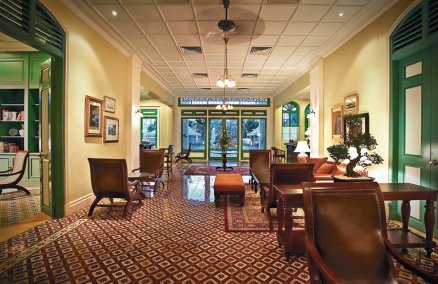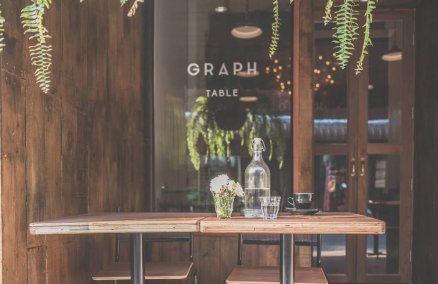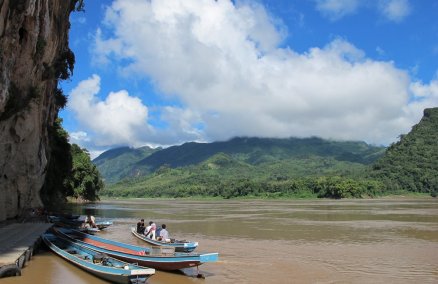SUPHANBURI
Samchuk
140 km / 2 hrs
Open daily, around 8am-5pm
Set on the banks of the Ta Chin River, Samchuk is one of the country’s most famous and authentic markets. The riverside site has been a trading spot for people living along the Ta Chin since the 18-19th centuries before roads made river travel obsolete. But in 2000, the community gathered and decided to revitalize the old market while preserving its original atmosphere. It turned out to be Samchuk’s largest development plan, taking nine years to complete. The market is now an award-winning example of old market revitalization that’s been copied by numerous markets across the country.
Highlights: Visit Khun Chamnong Jeenaruk Musuem to learn the history of the market through the lifestyle of a local noble who lived during the 1910-70s, before getting some black coffee at Raan Cafe Ta Ruea Song next to the entrance from the pier. Slightly odder is Baan Coke, a mini Coca-Cola museum displaying a vast collection of Coke-related products ranging from glasses to vintage ads. As for food, the old market serves up a variety of fare but you should try the noodles with supersized fish balls.
Bonus: A few more minutes of driving takes you to Buffalo Villages (www.buffalovillages.com) where you can check out the life of this animal beloved to Thai farmers. Travel further into Singaburi province, which is even closer than Amphur Muang, for the famous Mae La pla pao (grilled snake fish) places along Mae La River and one of Thailand’s largest reclining Buddha statues at Wat Phra Non Chaksi.
Kao Hong
97 km / 1.30 hr
Open daily 8am-5pm
If Samchuk is packed with hungry weekenders, Kao Hong is its quiet counterpart. Started with nine shophouses built by a Thai-Chinese rice tycoon as his trading headquarters on the banks of the Ta Chin River, the market was later expanded to three times the size and roughly divided into three zones: central, lower and the upper markets, where the rows of wooden shophouses are.
Highlights: We can guarantee veteran photographers and precious posers alike will fall prey to the old buildings’ charms, as there are numerous spots with an opportunity for good photos. Shop houses decked out with vintage furniture are also open for photo shoots for free—they don’t even care if you shop or not. Why so relaxed you ask? Because the rental fee is so cheap, locals tell us. At the center of the market there’s a four-story tower that locals would use as a fort to watch out for intruders in the old days.
Bonus: As the location is not far from Suphanburi town center, this is a chance to explore one of Thailand’s cleanest and tidiest cities with tourist landmarks like the Banharn-Chamsai Tower where you can get the elevated panorama of the entire city and the Dragon Descendants Museum (Open Wed-Mon, 10am-4pm. Entry B299 for Thais, B499 for foreigners) where you can explore the long history of Chinese families and communities in Thailand.
RATCHABURI
Chet Samian
92 km / 1.30 hr
Open Fri-Sun, 3-7pm. Art performances every last weekend.
These past couple of years, the status of the Chet Samian community and its local market have been elevated to a truly “cool” old market destination easily reached from Bangkok. It’s mostly thanks to the promotion of Patravadi Theatre’s Suan Silp Baan Din project and its founder, the Silpathorn award-winning Manop Meejamras, whose family is originally from this district. Compared to other markets, Chet Samien is really tiny: there are around 20 shophouses facing each other on the street that leads to the river. The super quiet market on weekdays turns into a bustling market every Sat-Sun with the influx of Bangkokians, and the last weekend of every month, sees performaces from Suan Silp Baan Din.
Highlights: They have this amazing chicken that they bake in a jar over burning coal, so that the chicken has a delicious smoky flavor. But the true highlights are art performances curated by Manop Meejamras. For your first visit, drop by at Chet Samian Local Museum for a collection of old photos and artifacts covering the history of the community before strolling around the stalls and shophouses. A small riverside stage sits at the end of the market’s street. This is not only where you watch all the performances but it’s also a spot to enjoy a beautiful sunset.
Bonus: As Chet Samian is located in Potharam district, a walk around Potharam Market (15km away) will complete your vintage Ratchaburi itinerary. Around five time larger than Chet Samian, Potharam Market features restaurants, old movie theatres, galleries and Chinese temples.
SAMUT PRAKARN
Khlong suan
80 km / 1 hour
Open daily, around 8am-5pm
Just 30 minutes away by motorway (exit at Ladkrabang), this place is a foodie paradise within reach of urban mortals. From the entrance, Khlong Suan is packed with food stalls selling every old recipe under the Siamese sun, like the rare kanom dok jok, a fried dessert in the shape of flower. Situated on Pravetburirom canal, this old community harking back to the King Rama V era used to be the top shopping spot for people who traveled along the canal linking Bangkok and Chacherngsao. Though it’s divided along provincial lines—Samut Prakarn and Chacherngsao—Khlong Suan is famous for its laid back living, harmonious Chinese and Muslim communities and great coffee shops.
Highlight: Funny how places with good quality of life always have the best coffee shops. The must-visit is Pae Li. This coffee house is particularly popular for its grandpa, who has appeared in every media outlet out there. Even though he’s in his 80s, he still serves every drink and smiles to any camera approaching him.
Bonus: Along the way to Khlong Suan, you will pass stalls selling the famous pla salid (deep fried fish) from Bang Bor which is the best and the biggest pla salid-producing area in Thailand.
Bangplee
50 km / 45 minutes
Open daily, around 8am-5pm
The old Bangplee market is one of the nine major markets in the eastern province. Originally named Sirisopon, Bangplee floating market is the only old market in Samrong to have survived both fires and new developments, still boasting the same architectural style it had when it was built 150 years ago. The wooden walkway stretching along the river at least 500 meters is still strong enough to handle thousands of tourist every day. Along the way you will find many old relics for sale, like antique bowls or lanterns. As it’s situated near Bangplee Yai Nai temple, there’s a focus on items for monks and temple but don’t underestimate the rest of the market because its many wooden shops are packed with plenty of delicious stuff.
Highlight: If you wake up too late, you’ll miss the famous, half-century-old gway tiaw moo which runs out as fast as 1pm. You can be comforted by kanom jeen Pa Mol where the lovely Mol and her daughter serve their delicious nam ya (curry soup)every weekend. Choose from kati, nam prik, curry and gaeng tai pla, all at B25. And don’t forget to treat yourself with kanom chan (layered pudding) Mae Boonsri, cooked daily according to the traditional recipe.
Bonus: Other than food and old junk, this is fortune teller central. Nearly one in every 10 shops of this community is in the business. But if you don’t believe in destiny, just walk to Bangplee Yai Nai temple to pay homage to Luang Por To, one of the famous Buddha statues in Thailand, and pray for some luck instead.
Chacherngsao
Ban Mai
80 km / 1.30 hour
Open daily, 8am-5pm (some shops only open on weekends)
Banmai Market, in Chacherngsao harks back to Rama 4. The market was created by Chinese immigrants who built their homes along the Bangpakong (Ta Chin) River long ago, and it slowly became the economic hub of Chacherngsao. It remains famous to this day, having served as a location for TV series and movies such as Yoo Gab Gong and Nang Nak.
Highlight: You can’t miss Ban Pa Nu, a riverside restaurant in Ban Mai, which specializes in pla chon lui suan and tom yam goong mae nam with ingredients coming from the Bangpakong river. For desert, venture over to Mae Wong’s for their stellar lod chong.
Bonus: Don’t forget to pay respect to the Luang Por Sothorn Buddha statue, legendary cousin of Luang Por To in Sumut Prakarn. You can also cruise along Bangpakong River to see the riverside communities. To visit these destinations, catch the boat from Luang Por Sothorn Temple to the Banmai market B100.
Nuengkhate
80 km / 1.30 hour
Open every weekend 9am-4pm
This market has only been in operation for about two years, but the Nuengkhat canal that it floats upon was originally dug by order of King Rama 5. He envisioned this canal to be a short-cut to Bangkok via the San Saeb canal. As the roadways developed, Nuengkhat canal was no longer needed and it was abandoned. Two years ago the mayor initiated the revival of the canal to be used as a market venue. Its pleasant design allows for an open feeling that will please market-goers who don’t like large crowds.
Highlight: Other than attracting visitors for their yummy hor mok pla chon (steamed fish with curry paste), Ban Ta Nai is a popular place because it is home to Miss Universe Pui-Pornthip Nakhirankanok’s grandmother. Fans flock here to take a picture with the elderly lady, who created her own original curry paste recipe. Make sure to sample various kinds of noodles such as guay tiew pak mor and guay tiew nam tok moo, as cheap as B10 per bowl, and Pae Sua’s guay tiew ped. If that doesn’t fill you up, then vendors in their boats line the canal selling all kinds of delicacies.
Bonus: Visit the all-pink, biggest reclining Ganesha statue in Thailand at Samanratanaram Temple or Wat Maikhunsaman in Chacherngsao. If you’re scared of rodents, watch out for the three giant mouse statues there.
Too lazy to drive? Check out these markets in the city.
Advertisement















